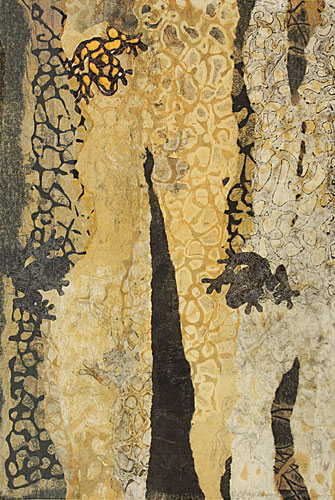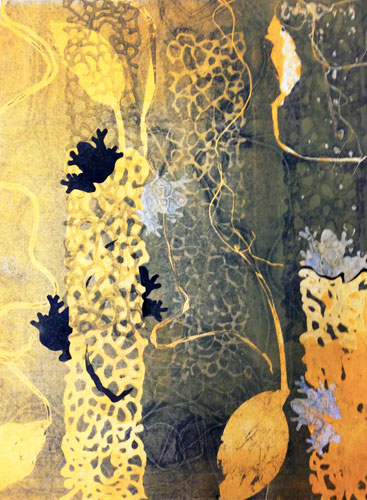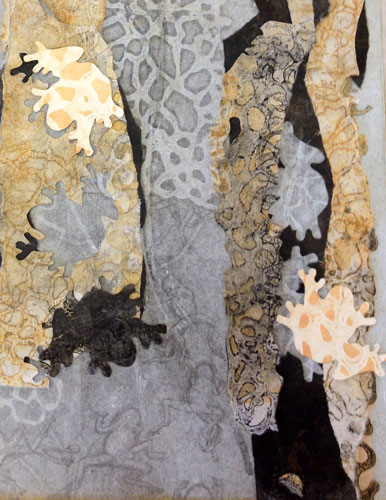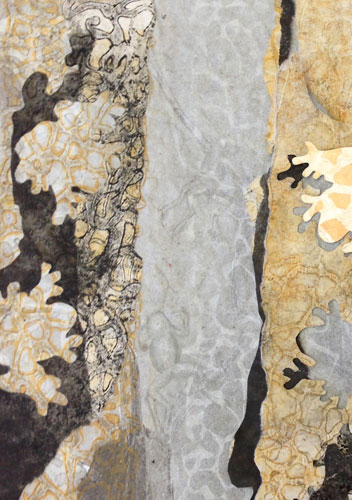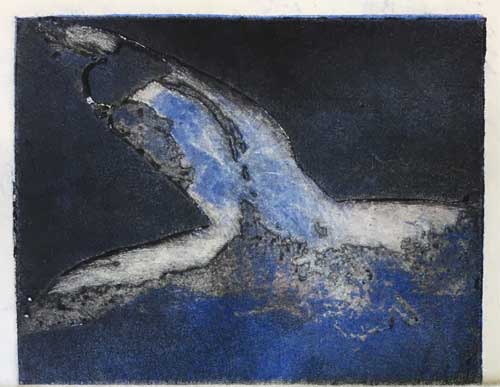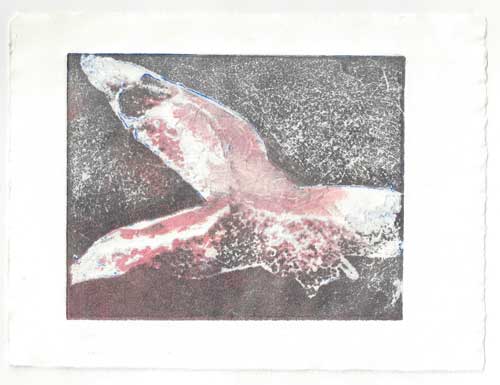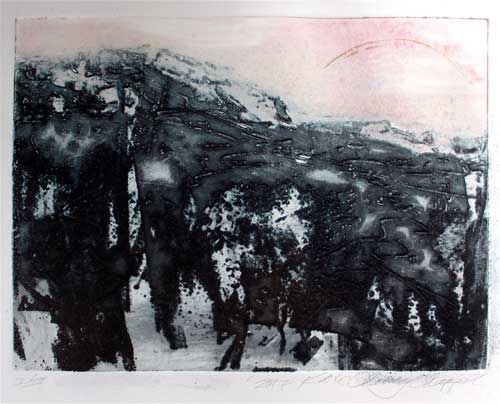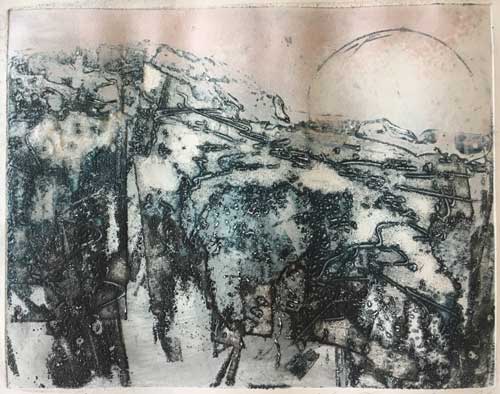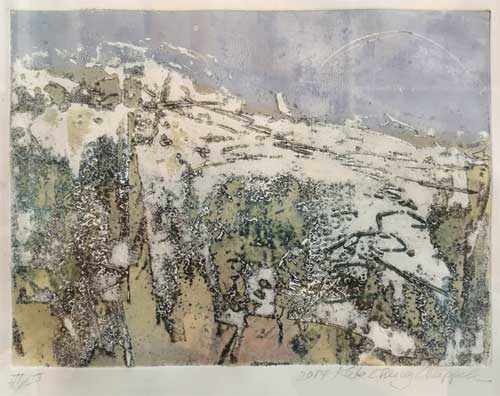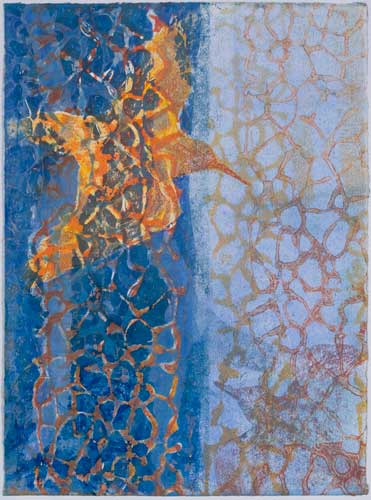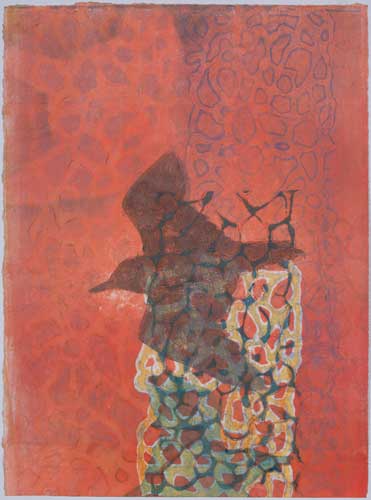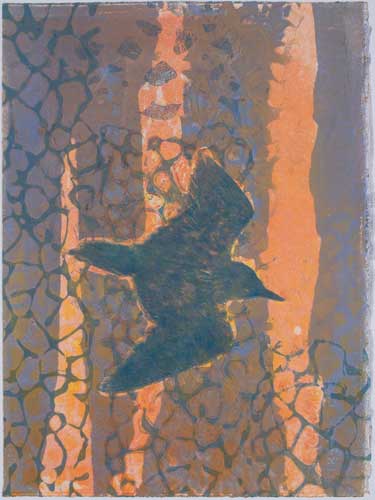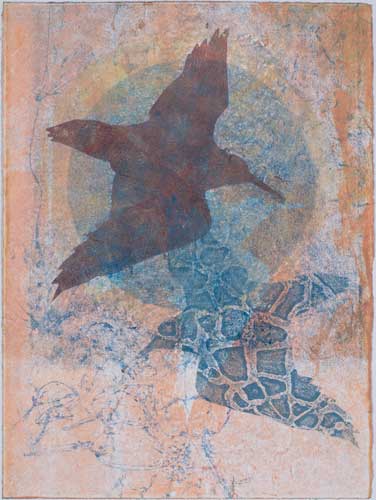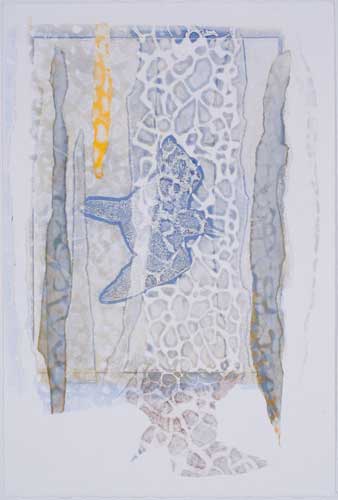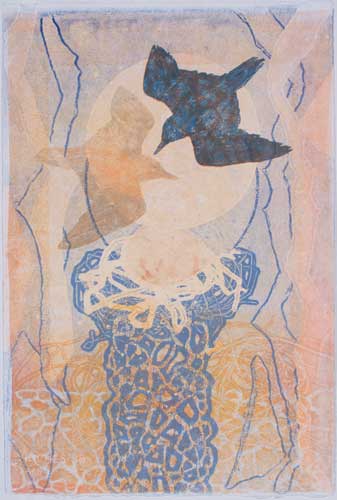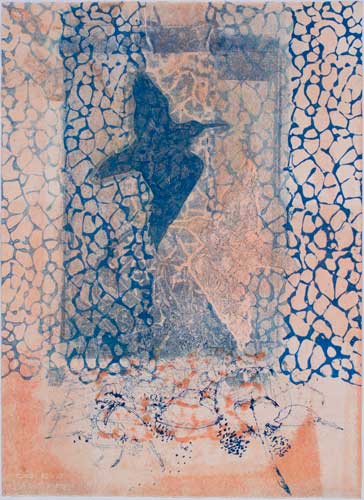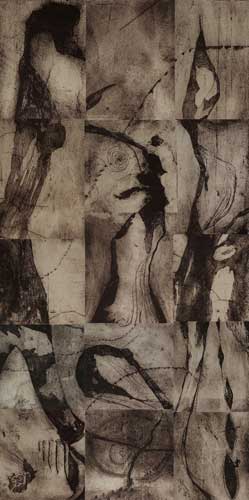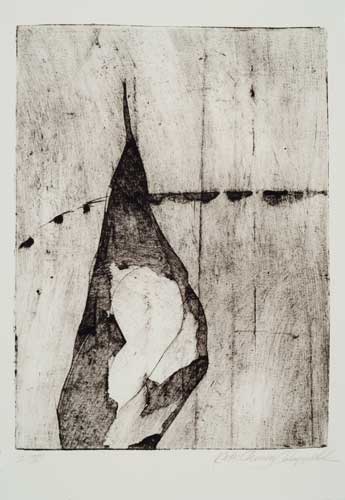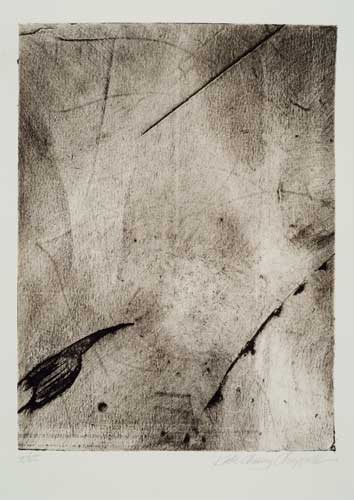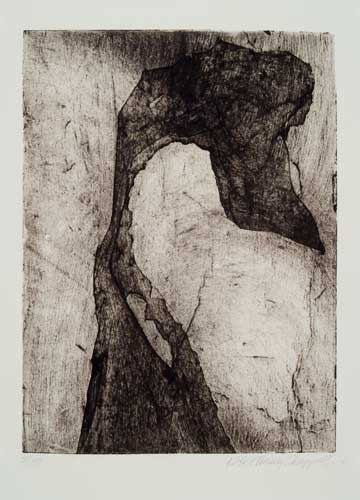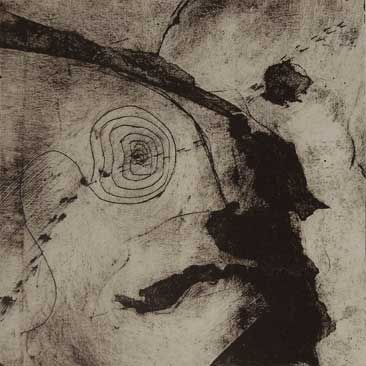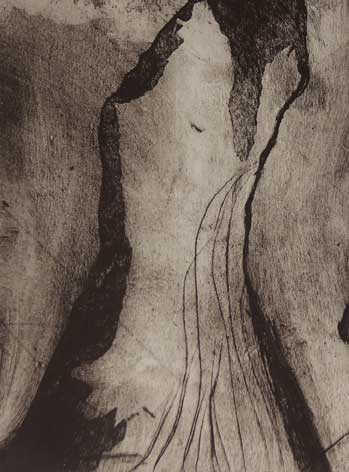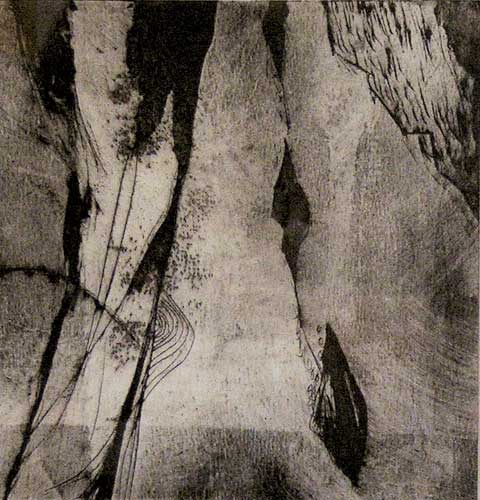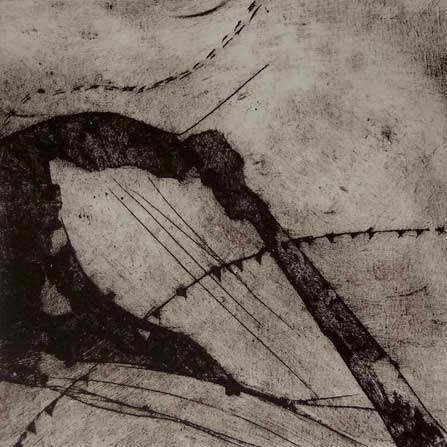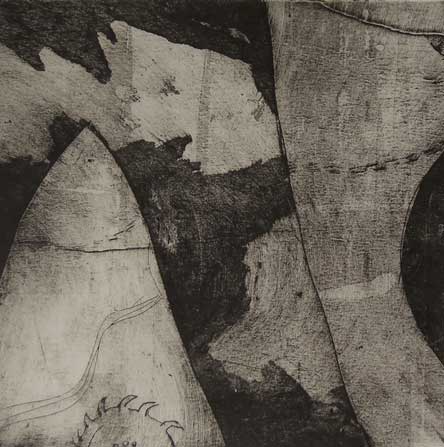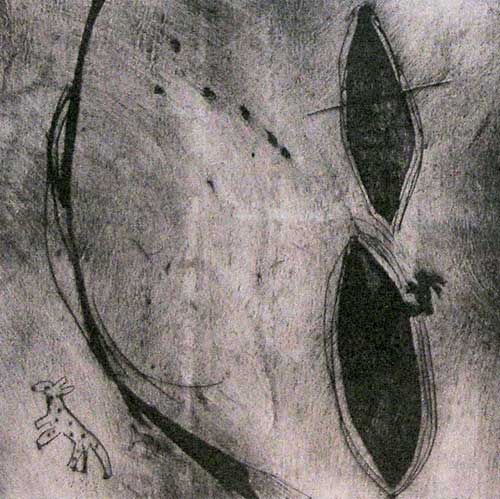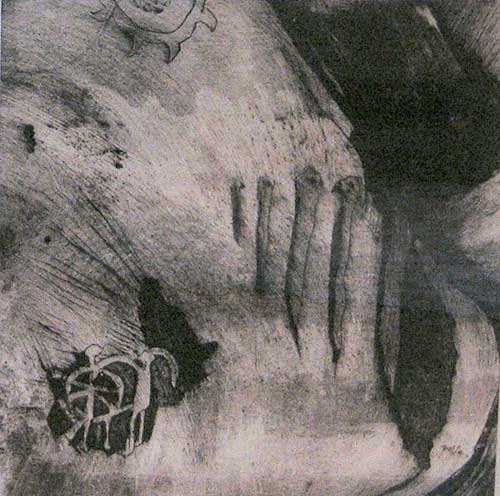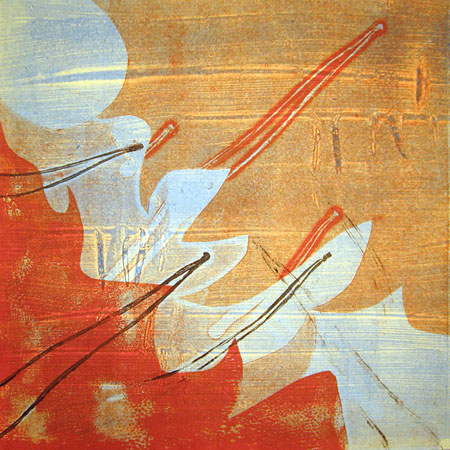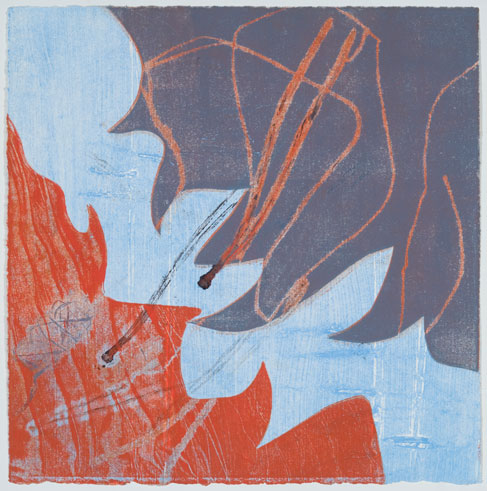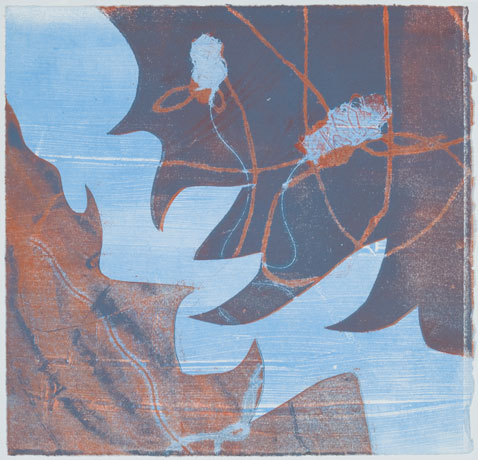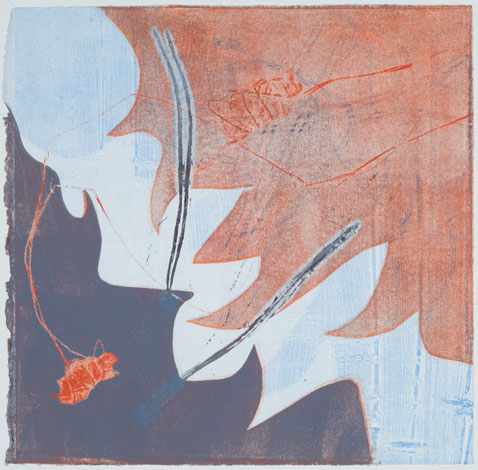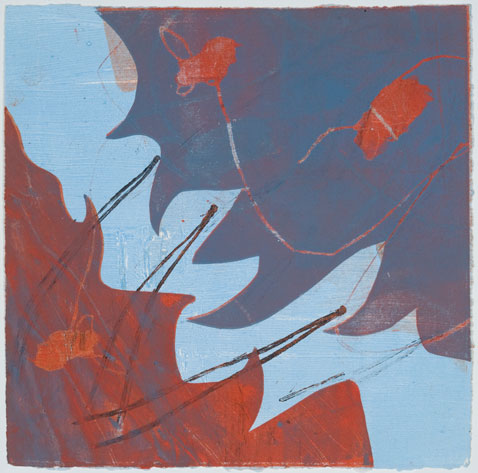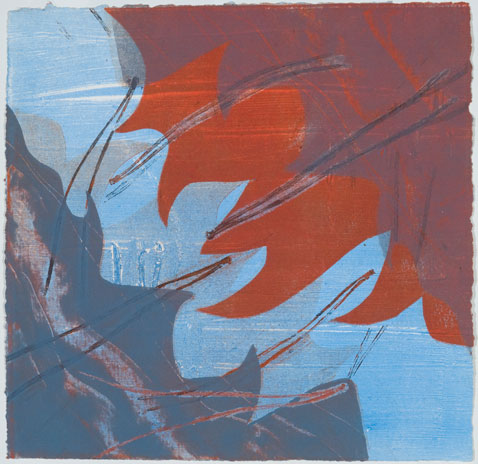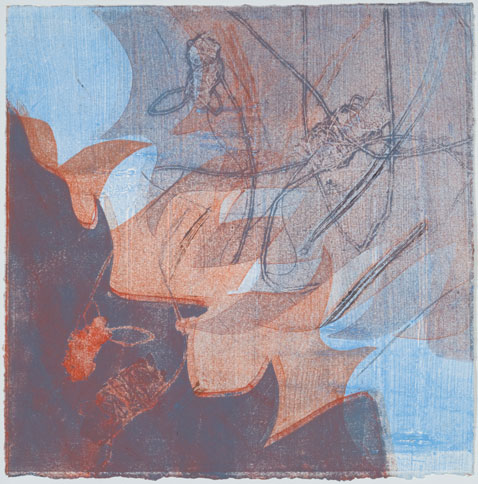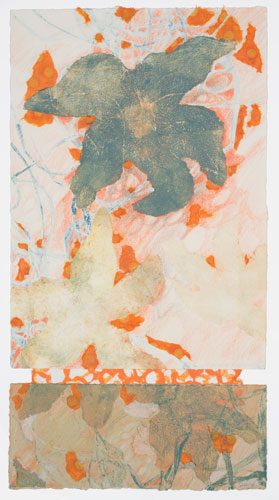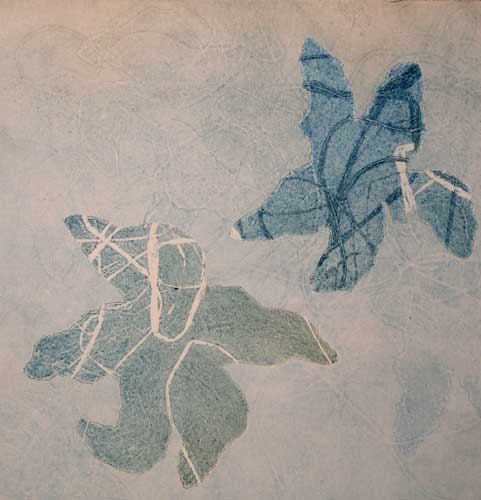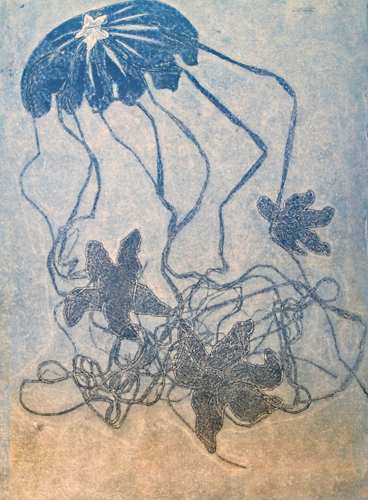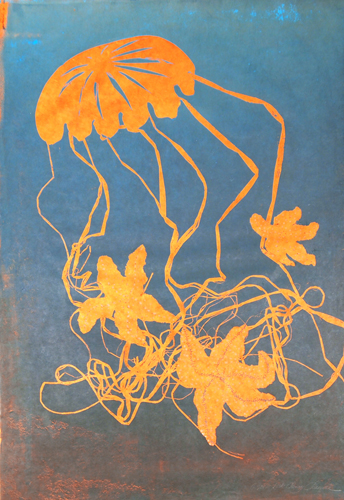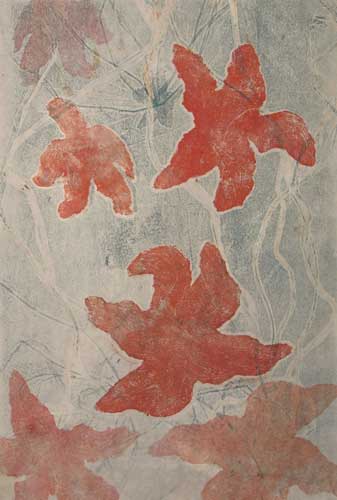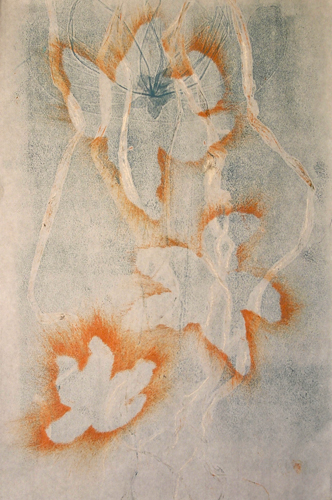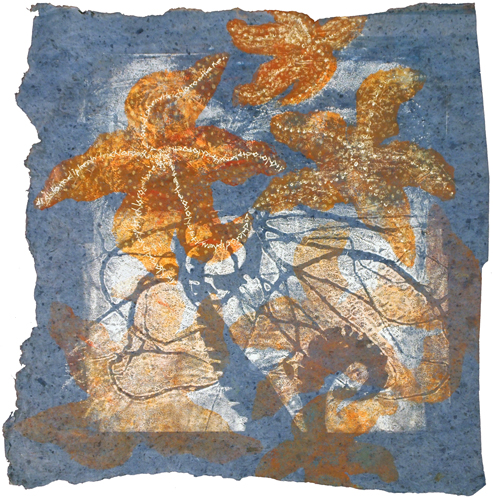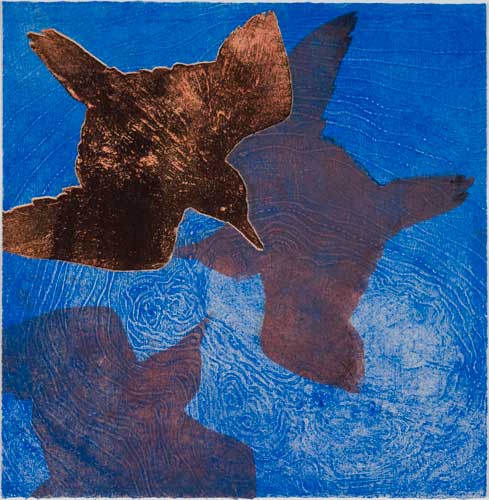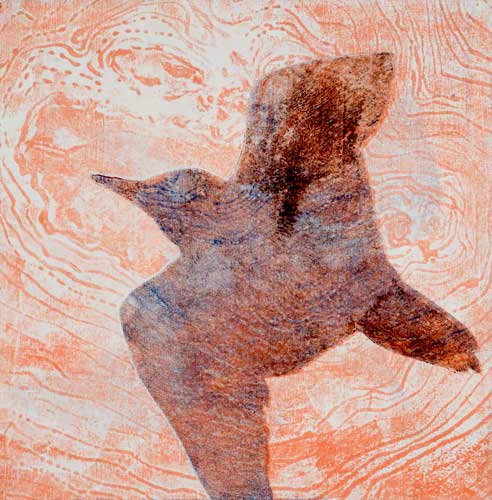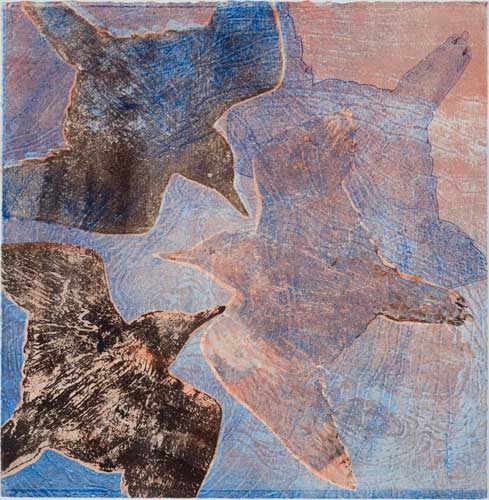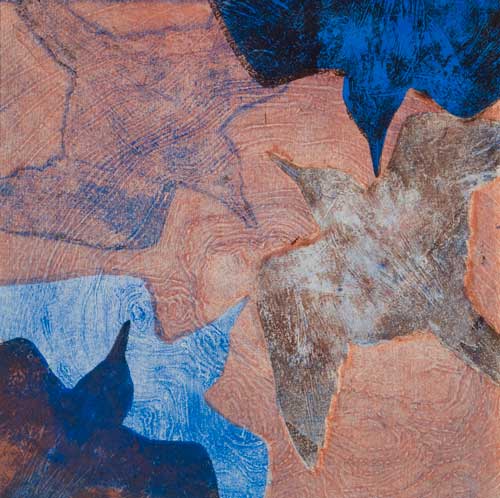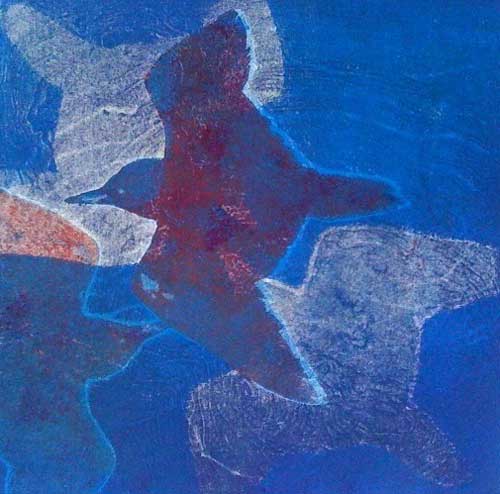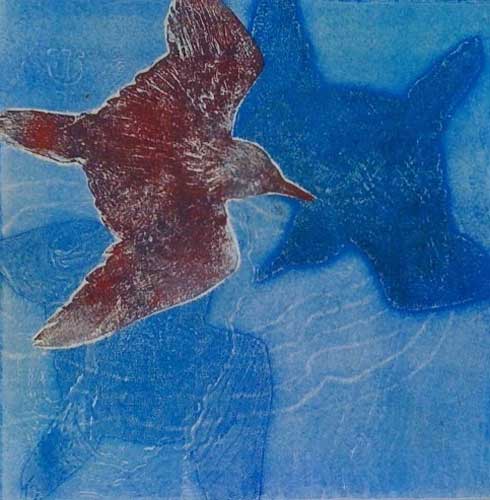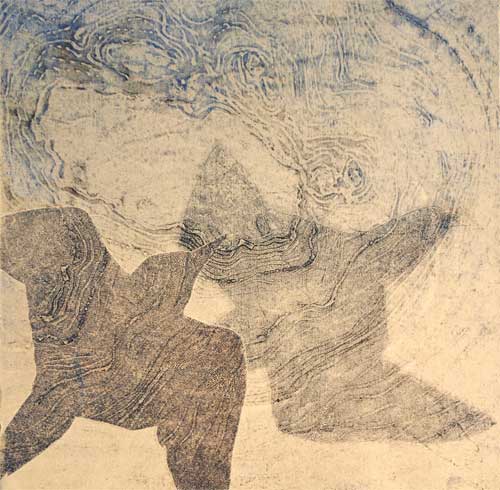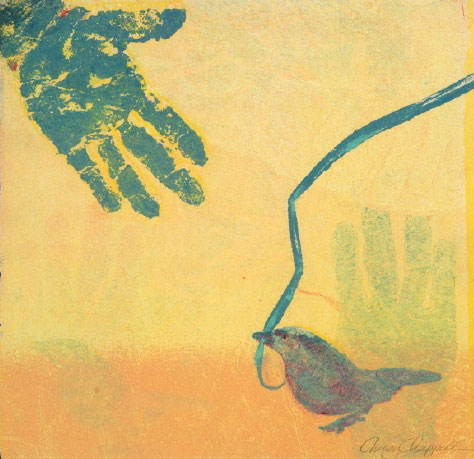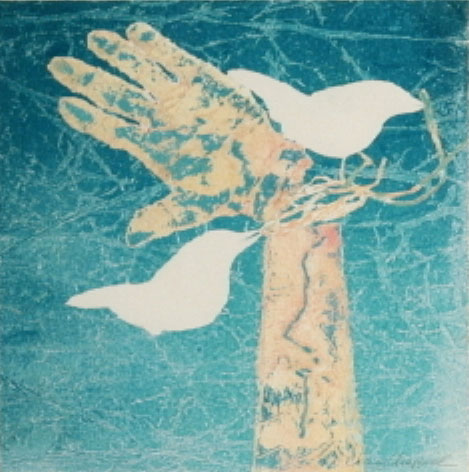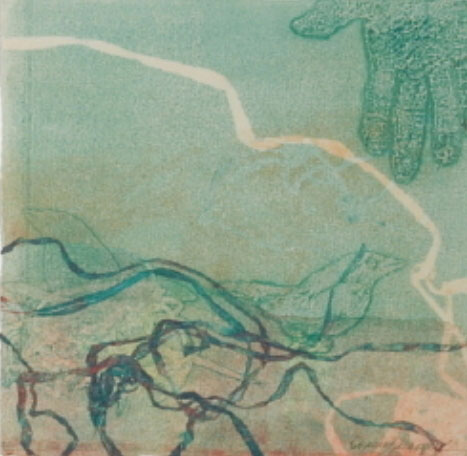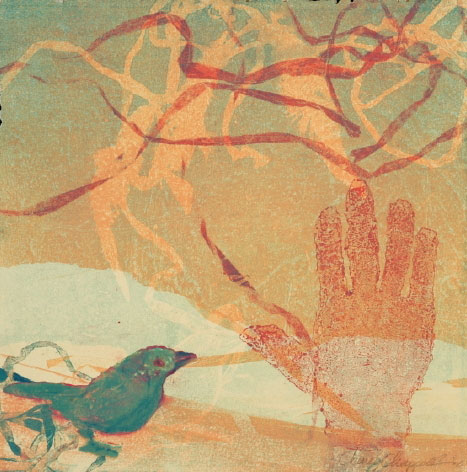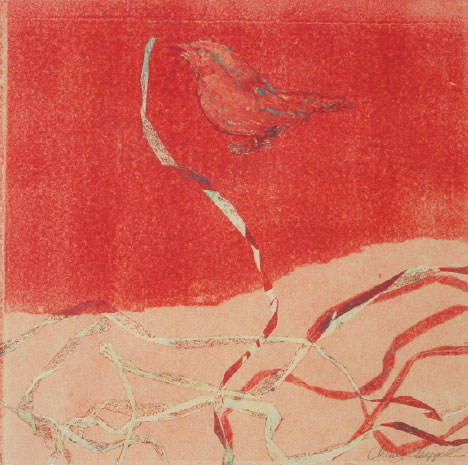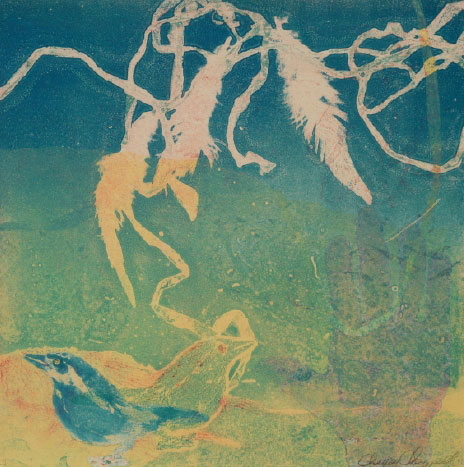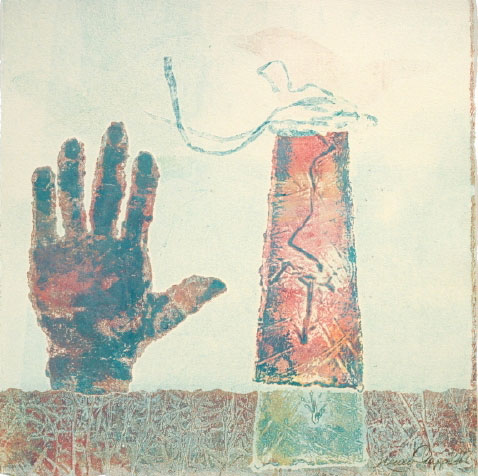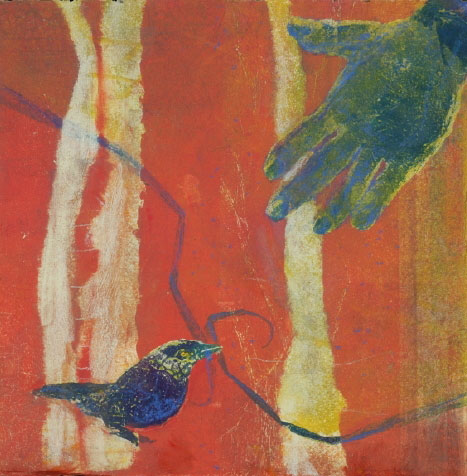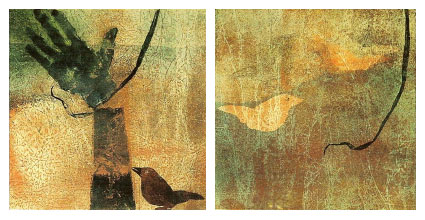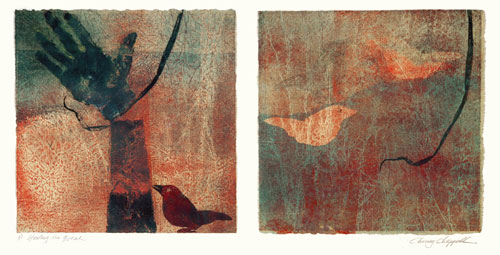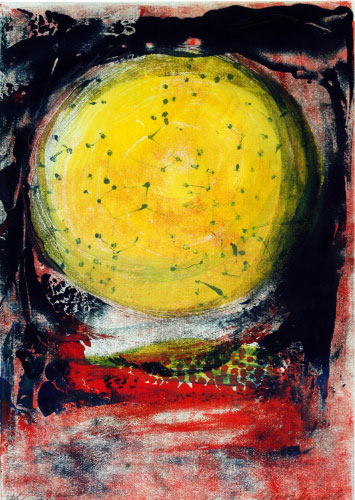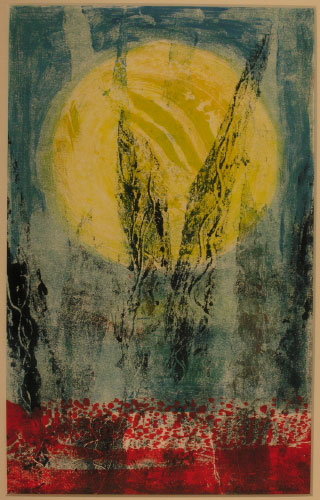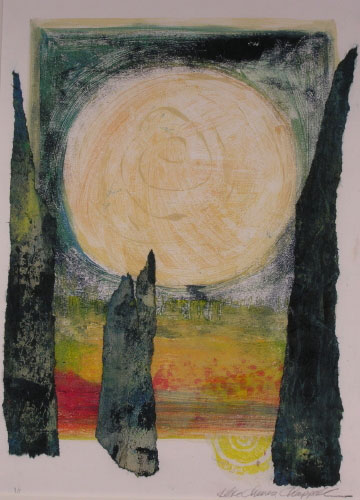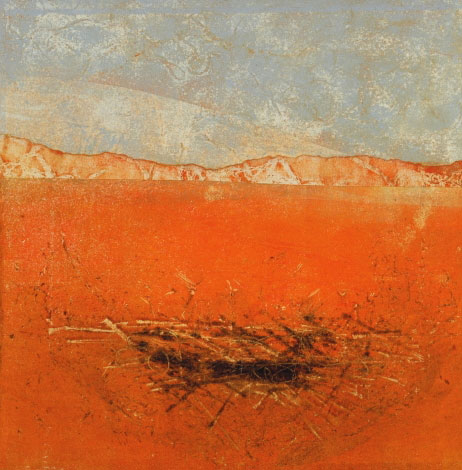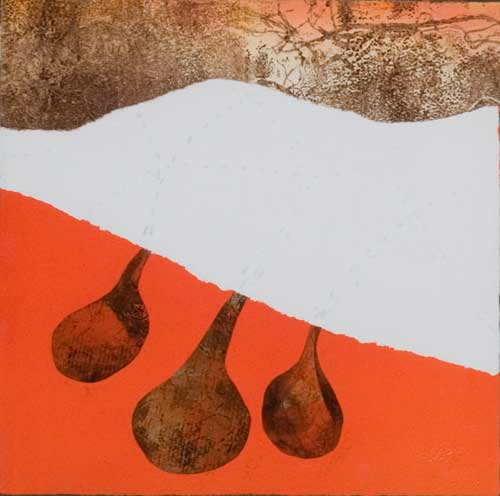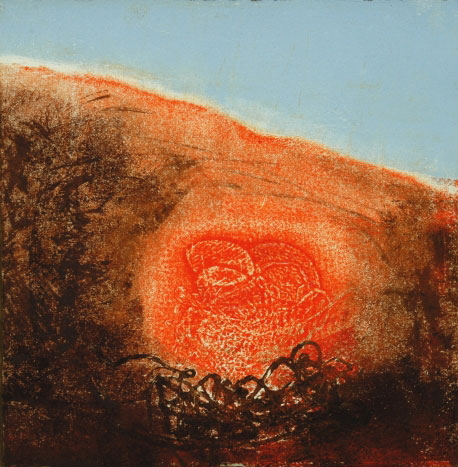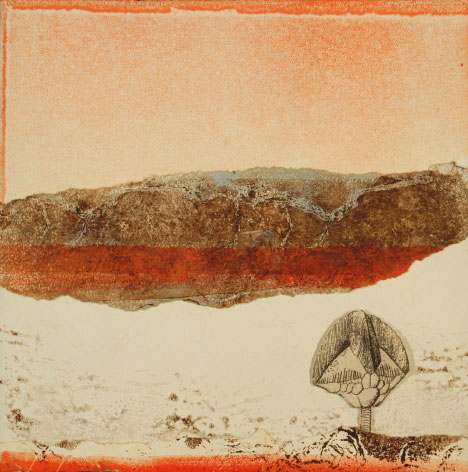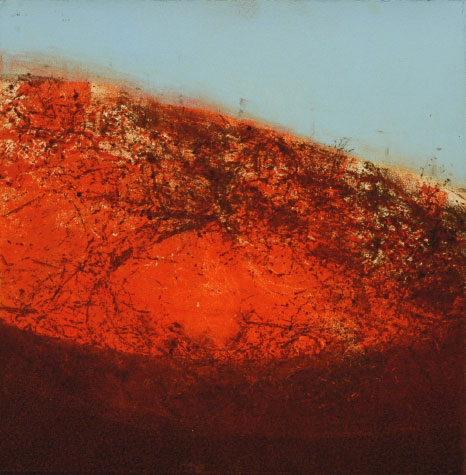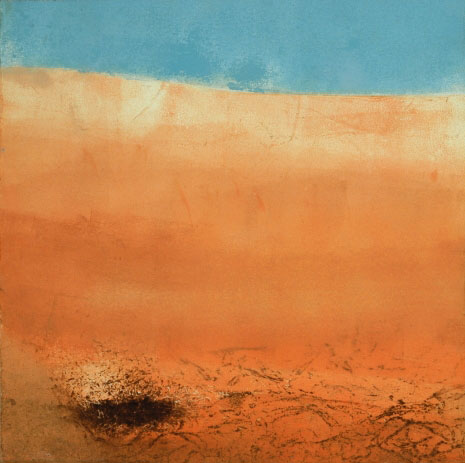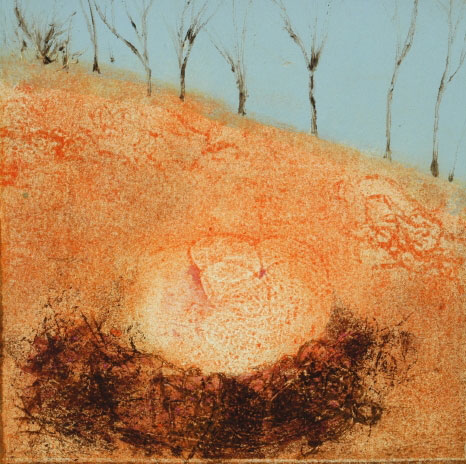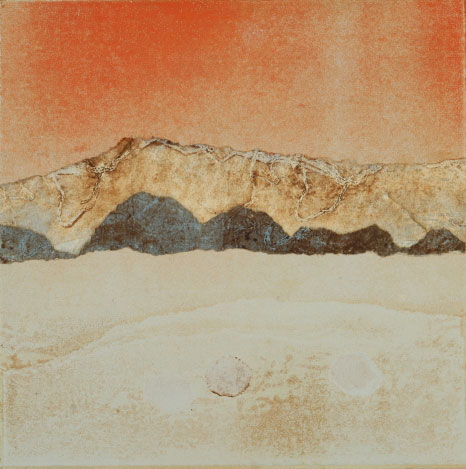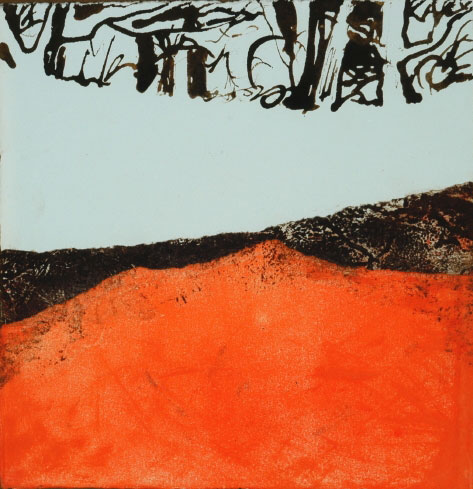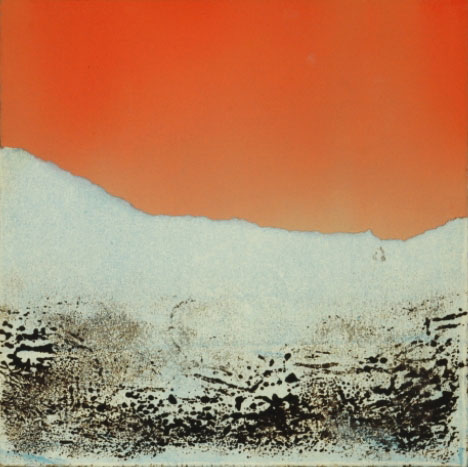I studied etching in Paris during college, but since then have learned many non-toxic printmaking techniques, at Maine College of Art and through Peregrine Press, a printmaking collective in Portland. Monotype techniques appeal to the painter in me, and of these, collagraph proved to be the most versatile for my process.
What is a collagragh? Think COLLAGE plus GRAPHIC. To make my plate, I use gesso on museum board cut to the size I want; while it is the consistency of toothpaste, I mark into and embed things in it that become part of the permanent plate. Sometimes my plates are made from torn Rives BFK paper and gesso in shapes I want, marked on both sides. I seal the plate with shellac and let it cure. Then it’s ready to apply the oil-based etching ink I use (Charbonnel), wipe with a tarlatan as I would an etching, and print successively, using both sides. This layering achieves the depth and mystery I am after.
Earth Matrix
This suite of collagraphs explores our frayed relationship with the natural world, in particular, the harm done to frogs and other amphibians as a result of human contamination of their habitats. Many species that contribute to this fragile web we call life are threatened; the world wide decline in frogs and an “explosion in amphibian deformities” came to my attention when I read an article in the National Geographic on the “Sixth Extinction.”
I drew my own “web” using liquid mediums that I mixed so they would harden into a printable, reusable matrix. The many layerings of interrelatedness in nature are reflected in and through this reticulated matrix. The frog imagery that dances in and out of the matrices are sometimes whole, but on closer inspection, graphite drawings of deformed frogs can be made out (see “Earth Matrix II: Ghost Frogs”), based on lab specimens reported in the article.
I also wrote a poem The Decline and Fall of Frogs to accompany this suite of prints, which you can read here.
Icelandic Odyssey
Over the summer solstice, I was one of five members of Peregrine Press to travel to Iceland for a two-week long residency in printmaking. We joined Sola, our Icelandic host, and Mary, our fellow printmaker from Ireland, for an intensive exploration of solar printmaking in this amazing country of fjords and glaciers. While there, I was inspired by how the angular volcanic rock defines the coast and litters landscape. The glacier, like a mythic beast, rises from the treeless tundra. Arctic birds, from the huge pelagic Fulmar to the small arctic Tern, stitch the shore in flight and whales sound in the North Atlantic waters.
Joining Iceland, Ireland, and Maine we have together formed the international printmaking group “Touching Water.” We are always in touch by the waters that touch each other’s shores, and we meet once a year to print together.
Moonbird
“Moonbird” is a series that tracks the amazing migration of the Red knot bird (Calidrus canutus) from Tierra del Fuego to its breeding ground in the Arctic, with seven stops along the way. It’s the longest migrating bird in the world and one of its species has been tracked (he’s an unbelievable 21+ years now) the distance of his total peregrinations equivalent to the moon and halfway back.
The moonbird has a special relationship with the ancient Horseshoe crab (Limulus polyphemus) on whose eggs she relies for high energy food on her journey.
Ancestral River
“Ancestral River” is a suite of intaglio prints that I made during a residency at the Vermont Studio Center in January 2009. Each image stands alone, but when all the individual plates are assembled on order, a larger image is created.
Much of my art explores our connections to the animal world as well as the early art of our foremothers and fathers who made the first marks in caves and in the crafting of implements and vessels. The river is a metaphor for the continuous flow of the creative spirit from prehistory to the present. Rivers also provided abundant fishing and the fertile alluvial soil that allowed our ancestors to farm. Images of people in fertility rites are based on early Bronze Age carvings from the Bohuslän district of Sweden; perforated bone points are from Upton Lovell, near Avebury, in Britain.
Ocean Arabesque
Surrounded by the sea on the island of Monhegan where I live part of each year, my thoughts are creatures of the deep. Protozoan to leviathan, they weave in and out of the depths, in a dance from dark seabed to light -filtered surface. What do I really know of myself? I am an intricate pattern of thoughts, feelings, impulses that dart in and out of my consciousness. In the layering act of making these monoprints, I catch a glimpse of myself as part of a greater ecosystem.
These are monoprint collographs with linoleum stencil, and conifer needles; an edition of 12 10″ x 10″ prints were created in 2013.
Medusa/Starfish
Tangled in Medusa’s tentacles, myriad starfish illuminate my imagined sea world. I made them out of torn paper and gesso, marking their spiny top surface with the rind of a cantaloupe. Once dried, I used them as satellite printmaking “plates”, scattered over the paper’s surface in a dance with the jellyfish. These same “plates” star in the installation, “Go Inside the Stone.” On some, an ominous script—the word, for DDT spells the contours of the starfish’s five arms. Medusa in Greek comes from the feminine present participle, medein, meaning to protect, rule over. In Greek mythology, the one who looked into Medusa’s eyes was turned to stone. Does our desire to rule over nature put us in danger of turning to stone?
Migration24
The migration of birds marks the seasons on Monhegan Island where I live, 12 miles off the coast of Maine. Rachel Carson spent her summers on nearby Southport Island, where she observed the same phenomenon. Like the birds, I return every spring to touch down for nourishment, rest, and re-creation. I have made multilayered collagraphs to evoke this migration of body and spirit. I construct plates using a collage method, building up layers of rag paper on board with gesso, incising and embedding into the plate. Two plates work in tandem: the sea surrounding the island mass, and the bird itself, a two-sided plate that can be positioned freely and printed on both sides.
Healing the Break
I broke my wrist in 2006, and it forced me to change many things in my life in order to heal, including the art I made. The birds in this suite of collagraphs are based on the recently rediscovered golden-fronted bowerbird from the deep rainforest of Papua New Guinea. I dreamt they were knitting my bones in place (see the article, New Species Found in Lost World of Indonesian New Guinea.) Healing happens in mysterious ways. We have a choice when we respond to breaks in our lives: the creative act has power to heal. In 2011, Healing the Breakbecame part of a collaborative art project, Painters, Players, and Poets when Cindy Bullens wrote a song in response to it, also titled Healing the Break.
Navigating by Heart
These monotypes use the constellations of the summer sky, moon and monolith as imagery. Made on Monhegan Island, where celestial navigation is understood and used, and where my heart abides.
Wintering Over
This suite of monotype/collages speaks to our kinship with all living creatures and our desire to find those safe burrows, dens and nests in which to protect and “winter over” what is essential in us, our creative core. The extreme cold and constant white of my surroundings in Vermont (VSC residency 2007) was a backdrop for my explorations of warmth and life, grounded in the earth, connected to her fiery center and regenerated every year through seed, egg, idea—a manifestation of what is becoming from what is hidden, buried, dark.

